
When news broke that two Chicago police officers were involved in a shooting in the Englewood community, it jolted the City. The shooting that took the life of Ella French, a 29-year-old Chicago Police Department (CPD) veteran officer, and the severe wounding of her partner by brothers, Emonte and Eric Morgan, is reminiscent of the almost 40-old shooting death of CPD officers William P. Fahey and Richard James O’Brien.
In 1982 the arrest of brothers, Andrew and Jackie Wilson, in the killing of officers Fahey and O’Brien during a routine traffic stop in the Gresham community left the City on edge. Both brothers were convicted, but for reasons related to the infamous reign of disgraced and fired CPD Commander, Jon Burge, the Supreme Court of Illinois later reversed Andrew Wilson’s conviction citing police coercion of his confession.
Recollections of that frigid February day four decades ago are hard to erase. Seared into my memory are several hundred police officers converging on and occupying my former neighborhood. It was the second time I’d witnessed throngs of CPD uniformed and plainclothes law enforcement officers overrun a black community. The first time was December 4, 1969, when law enforcement officers killed Black Panther Party chairman Fred Hampton and defense minister Mark Clark on the West Side of Chicago in the wee hours of the morning.
Similar to the killing of officer French, officers Fahey and O’Brien died while making a routine traffic stop. However, the incident that came to be known as the “Biggest Manhunt of the Decade” saw law enforcement personnel fan out over the neighborhood searching for the outlaw Wilson brothers.
Reaction to the shooting of Officer French and similar cases of police officers being killed, or wounded, during a traffic stop prompts many to ask, “what the hell happened? And, how does a routine traffic stop end in the shooting of a police officer, or citizen?
Similar to the Wilson brothers, the court denied bond for the Morgan brothers charging them with fatally shooting a uniformed police officer. Although a cursory look at the cases might lead one to believe that the similarities between the Wilson and Morgan brothers might end there, however, there are compelling parallels that warrant further examination by criminal, mental health, and sociological, professionals.
Of course, there are numerous contributing factors, including structural inequity, systemic racism, and inadequate police training. However, the most likely factor playing a role in both tragedies is the element of fear. And, it’s the fear factor that presents an intriguing sociological aspect, prompting the question, how did two blood-related brothers come to participate in such a heinous crime?
We already know about the fear and trepidation that some black people harbor for police officers. Many feel that the police don’t understand the terror unleashed during a traffic stop. As it relates to police personnel, fear of the unknown, unfamiliar, and unexpected increases volatility ramping up the potential for violence.
What’s different is that unlike the Wilson brothers, who had extensive criminal records, the Morgan brothers do not. It’s possible that, on any other day, Officer Evans and her partner may have encountered a compliant Emonte and Eric Morgan. However, the colliding factors of fear and fate likely created circumstances for such a cataclysmic event.
Amid the shroud of sadness hanging over Chicago, and the Nation, Anjanette Young, who is suing the city over a 2019 CPD raid at her home, said that Officer Evans, who was on the scene during the botched police raid, “was the only one who showed her dignity or respect.”
The prosecution of the Morgan brothers will do little to ease the fear and distrust of law enforcement that grips large segments of the black community, or to calm a systemically racist police force paralyzed by fear,
Anthony Stanford, who was named the 2014 Outstanding African-American of the Year by the Aurora African-American Heritage Advisory Board, is a columnist and author of the book, “Homophobia in the Black Church: How Faith, Politics and Fear Divide the Black Community.”

